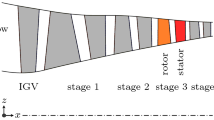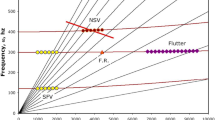Abstract
The recent progress in Multidisciplinary Design Optimization (MDO) enables engineers to revise design strategies and to address more complex problems. In this paper, the full design of a compact highly loaded fan for aerospace applications is considered. The design comprises several conflicting objectives, such as aerodynamic efficiency and structural integrity. Optimization techniques are applied at every stage of the design, leading to a reduced and accelerated overall process and an enlarged design space. Performance of the machine are first evaluated by through-flow modeling (low-fidelity radial distributions based on experimental correlations) to determine an optimal flow path configuration. High-fidelity aero-mechanical performances are then considered to generate the detailed design of the rotors, including section profiles along the span, as well as lean and sweep. The multi-objective algorithm enables one to consider simultaneously Computational Fluid Dynamics (CFD) and Computational Structural Mechanics (CSM). The methodology is applied to the design of a compact highly loaded fan achieving a 2.1 pressure ratio with an efficiency of 88 % while satisfying the mechanical constraint of titanium with a safety margin of 32 %. The proposed approach allows to generate an original configuration with a reduced time to market.

















Similar content being viewed by others
References
Arnone A (1994) Viscous analysis of three-dimensional rotor flow using a multigrid method. J Turbomach 116(3):435–445
Calvert W, Ginder R (1999) Transonic fan and compressor design. Proc Inst Mech Eng C 213(5):419–436
Cunnan WS, Urasek DC, Stevans W (1978) Design and performance of a 427-meter-per-second-tip-speed two-stage fan having a 2.40 pressure ratio. National aeronautics and space administration. Scientific and Technical Information Office, Washington
Deb K, Pratap A, Agarwal S, Meyarivan T (2002) A fast and elitist multiobjective genetic algorithm: Nsga-ii. Evolutionary Computation. IEEE Trans on 6(2):182–197
Dhondt G (2004) The finite element method for three-dimensional thermomechanical applications. John Wiley & Sons, Ltd, Chichester
Dickens T, Day I (2011) The design of highly loaded axial compressors. J Turbomach 133(3)
Fonseca CM, Fleming RJ (1995) An overview of evolutionary algorithms in multiobjective optimization. J Evol Comput 3(1):1–16
Goldberg D (1989) Genetic algorithms in search, optimization and machine learning. Addison-Wesley Longman Publishing Co., Inc., Boston
Joly MM, Verstraete T, Paniagua G (2013) Differential evolution based soft optimization to attenuate vane—rotor shock interaction in high-pressure turbines. Appl Soft Comput 13(4):1882–1891
Lakshminarayana B (1996) Fluid Dynamics and Heat Transfer of Turbomachinery. Wiley & Sons, Inc., Hoboken
Lian Y, Liou MS (2006) Aerostructural optimization of a transonic compressor rotor. J Propuls Power 22(4):880–888
Lichtfuss H, Starken H (1974) Supersonic cascade flow. Prog Aerosp Sci 15:37–149
Lieblein S, Schwenk F, Broderick R (1953) Diffusion factor for estimating losses and limiting blade loadings in axial flow compressor blade elements. National aeronautics and space administration. Scientific and Technical Information Office, Washington
Madavan N (2002) Multiobjective optimization using a pareto differential evolution approach. In: Evolutionary Computation, 2002. CEC’02. Proceedings of the 2002 Congress on, IEEE vol 2, pp 1145–1150
Merchant A (1999) Design and analysis of axial aspirated compressor stages. PhD thesis, Massachusetts Institute of Technology
Miller G, Lewus G, Hartmann M (1961) Shock losses in transonic rotor rows. J Eng Power 83:235–242
Pierret S, Filomeno Coelho R, Kato H (2007) Multidisciplinary and multiple operating points shape optimization of three-dimensional compressor blades. Struct Multidiscip Optim 33(1):61–70
Reid L, Moore R (1978) Design and overall performance of four highly loaded, high speed inlet stages for an advanced high-pressure-ratio core compressor. National aeronautics and space administration. Scientific and Technical Information Office, Washington
Sanger N (1996) Design of a low aspect ratio transonic compressor stage using cfd techniques. J Turbomach 118(3)
Shepard D (1968) A two-dimensional interpolation function for irregularly-spaced data. In: Proceedings of the 1968 23rd ACM national conference, ACM, pp 517–524
Storn R, Price K (1997) Differential evolution—a simple and efficient heuristic for global optimization over continuous spaces. J Glob Optim 11(4):341–359
Acknowledgments
This work was performed within the Long-Term Advanced Propulsion Concepts and Technologies II project investigating high-speed air-breathing propulsion. LAPCAT II, coordinated by ESA-ESTEC, is supported by the EU within the 7th Framework Programme Theme 7 Transport, Contract no.:ACP7-GA-2008- 211485.
Author information
Authors and Affiliations
Corresponding author
Rights and permissions
About this article
Cite this article
Joly, M.M., Verstraete, T. & Paniagua, G. Multidisciplinary design optimization of a compact highly loaded fan. Struct Multidisc Optim 49, 471–483 (2014). https://doi.org/10.1007/s00158-013-0987-5
Received:
Revised:
Accepted:
Published:
Issue Date:
DOI: https://doi.org/10.1007/s00158-013-0987-5




